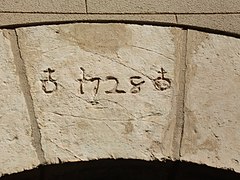♁
Jump to navigation
Jump to search
 | ||||||||
| ||||||||
Translingual[edit]
Alternative forms[edit]
(alchemy): 🜱 (for regulus of antimony / antimony metal)
Etymology[edit]
(Christianity, astronomy): A globus cruciger (the globe surmounted by a Christian cross), representing God's or the Church's rule over the redeemed world. Alchemical extension to newly discovered antimony motivated by an attempt to retain an association between the basic metals and the known planets. Astronomical use is reinforced by the graphic similarity to the symbol ⟨♀⟩ for Venus, the planet most similar to Earth.
Symbol[edit]
♁
- (astronomy) the Earth.
- (Christianity) the redeemed world (symbol carried by depictions of Christ and medieval Christian kings).
- (cartography) marks a church.
- (alchemy, archaic) stibnite (antimony ore, Sb2S3).
- (astrology, rare) the fictitious planet Proserpina, which one Polish school of astrology identifies as the dwarf planet Eris.
Usage notes[edit]
In contemporary astronomy, ⟨♁⟩ is particularly common in German-language sources. ⟨🜨⟩ is the usual symbol in English-language sources, but ⟨♁⟩ also occurs.[1]
Synonyms[edit]
- (astronomy, Christianity): 🜨
- (astrology): ⯘, ⯰, ⯱
- (alchemy): 🜰 (regulus of antimony / antimony metal)
Derived terms[edit]
- (astronomy): M♁ – Earth mass (as a unit of measurement).[2]
- (astronomy): R♁ – Earth radius (as a unit of measurement).
- 🜫 – antimony ore.
- 🜭 – antimony salt.
- 🜥 – copper antimoniate.
Gallery[edit]
-
A banded globus cruciger
-
As a Christian symbol on a date
(♁ 1728 ♁ = 1728 AD) -
As a planetary symbol on a plaque
-
Transit of Earth
Related terms[edit]
See also[edit]
- ⏚ (ground)
References[edit]
- ^ E.g. Beutler, Mervart & Verdun (2006) Methods of Celestial Mechanics, volume II: Application to Planetary System, Geodynamics and Satellite Geodesy
- ^ E.g. A. G. G. M. Tielens (2021) Molecular Astrophysics, CUP, p. 10;
Boblest, Müller & Wunner (2015) Spezielle und allgemeine Relativitätstheorie, p. 19.



